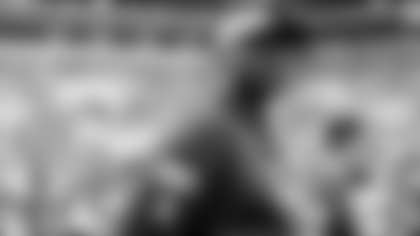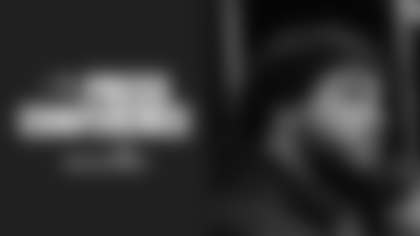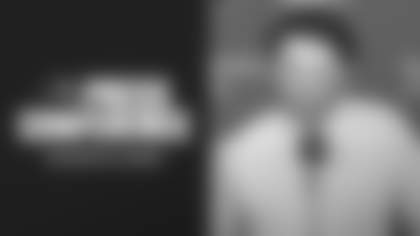Late in the month of June, as the Tampa Bay Buccaneers were winding down their 14-week offseason program, Head Coach Raheem Morris was asked to identify a player on his roster who might be ready to "make the leap."
In other words, what young Buccaneer who had established himself as at least a useful player might, in 2010, graduate to big-time producer? Or what player farther down the depth chart might carve out a more significant role?
Few NFL newcomers step immediately into stardom; most take a season or two to figure out the professional game, and their places in it. Whether it be a matter of maturation, opportunity or coaching, an above-average NFL career usually includes that one season where the player emerges from the crowd.
Ronde Barber barely played as a rookie in 1997, started opening eyes with big plays in his second year and by 1999 had begun his full-time run as one of the best defenders in franchise history. Barrett Ruud toiled behind Shelton Quarles and bided his time on special teams before bursting through a suddenly-open door in 2007. Up in New York, Derrick Ward hung around a crowded backfield learning from the Tiki Barbers and Brandon Jacobses before getting his shot in Season Four.
Who on the Bucs' current roster of 84 players might be ready to make such a leap? In June, Morris pointed to fourth-year linebacker , who is coming off his first year as a starter. Improvement down the stretch in 2009 plus a strong offseason plus the possibility of an expanded role in 2010 could be the elements that propel Black to the next level and prove his coach right.
There are certainly reasons to be optimistic about Black's immediate future, but of course there are no guarantees with any player. There is also no reason that Black would be the only Buc ready to make a big move in 2010. With training camp just days away, let's look at five more players on Tampa Bay's current roster who could be ready for the leap. In some cases, these are already-prominent contributors who could become brighter stars; in others, they are just-developing young players who could take on greater responsibilities and excel in them.
Note that we are not considering rookies in this analysis. The Bucs would be thrilled to get huge contributions from a Gerald McCoy or Arrelious Benn, but that would be that rarer scenario, a fully-formed standout taking the league by storm. Instead we're peering into Tampa Bay's rather deep pool of young and relatively unproven players for those men who have had a season or two in the NFL to shape their games. Here are five names we pulled from that pool, in no particular order:
**
WR Sammie Stroughter
One reason to believe the former seventh-round pick can catapult from his surprising rookie season to an even more prominent role in 2010: He is absolutely driven to succeed.
Behind Stroughter's easy smile and positive outlook is a killer instinct and an unmatched work ethic. Tampa Bay's draft history over the last dozen or so years is littered with seventh-round receiver gambles that never hit (Nilo Silvan, Nigea Carter, Darnell McDonald, Aaron Lockett, J.R. Russell, etc.) but Stroughter looked different from his first few days in Tampa. It helped that the team's scouts had a specific role for Stroughter in mind on draft day, feeling he could help immediately as a slot receiver.
Stroughter made that plan an immediate success and in fact had at least one catch in 11 of the team's first 12 games. Tight end Kellen Winslow was the top target in the passing game, finishing with 77 receptions, but the wideout corps was shaken by injuries and upheaval. Stroughter was a steady force, finishing with 31 catches to finish second only to Antonio Bryant among all wide receivers.
The additions of Reggie Brown via trade and promising draft picks Arrelious Benn and Mike Williams have refashioned that corps of receivers into a group with much more potential, but the roles within that group still need to be defined. Fully recovered from the foot injury that cost him the last two games of his rookie season, Stroughter is sure to fight as hard as anyone to carve out a prominent job.
The biggest question is, what job do the Bucs have in mind for the former Oregon State standout? Will he still be primarily a slot receiver in extra-wideout packages, thus limiting his time on the field somewhat? He's obviously well-suited to the role, given his size (5-10, 189 pounds), fearlessness and quick moves, and the Bucs have some larger prospects like Benn, Williams and Maurice Stovall to consider for outside roles. Or will that just be a jumping-off point for Stroughter, who has shown in the return game that he has speed and shiftiness to spare, and thus could be a legitimate deep threat?
**
LB Geno Hayes
Like Black, Hayes became a starter for the first time in 2009 and, like the Bucs' defense as a whole, he was a far more productive player down the stretch after Morris took over the defensive play-calling. Hayes had four of his seven passes defensed, both of his interceptions, all three of his sacks and 73 of his 136 tackles in the last seven games he played.
That change at defensive coordinator, a role Morris will hold on to in 2010, might be the best reason to posit a leap forward for Hayes. While it's an oversimplification to say the Bucs went fully back to a Cover Two defensive scheme under Morris, the current system definitely recalls much of what the team did from 1996-2008 under Monte Kiffin. Hayes, drafted in 2008 and possessed of more speed and instincts than brute size, is a good fit for that style. He's not as big as his Florida State predecessor Derrick Brooks, but he appears to be more of a pass rusher, and he's about as speedy a linebacker as the team has known.
His improvement down the stretch and the layout of the current depth chart would suggest that Hayes has a strong hold on the starting weakside job in Tampa, and he has exuded the confidence and comfort level that comes with such a situation. Also working in his favor is the presence of middle linebacker Barrett Ruud, who went through every step of the team's offseason program in order to get a firm grasp on the hybrid system that Morris is putting together. By the end of the program, Ruud professed his own solid comfort level with the scheme and, as the defense's quarterback on the field, he should help such young players as Hayes and Black be in position to make plays.
**
DE Kyle Moore
Like Stroughter, Moore was a rookie in 2009, but the former USC pass-rusher didn't get nearly the amount of playing time last fall as his wide receiver teammate did. Minor injuries slowed his development early on, and he wasn't much of a factor for the team through the first three-quarters of the season.
Morris, however, found use for the tall, long-armed defensive end during the final month and came away impressed. Then Moore kept adding to that impression with one strong offseason day after another, and suddenly Morris could see the second-year player becoming a serious part of his plans in 2010.
Moore is 6-5 and in the 270-280 range after dropping a few pounds this offseason in order to increase his speed off the edge. He's no pass-rushing specialist, however; the Buccaneers drafted him believing he could stop the run very effectively and eventually be an every-down player. Moore may have hastened the schedule with his strong 2010 offseason.
And, of course, Moore appears to have that most significant asset when trying to make the leap: Opportunity.
Starting left end Jimmy Wilkerson used free agency to head to New Orleans, opening up at least one full-time job. On the right side, Stylez G. White's eight starts paced the team; only early-season acquisition Tim Crowder backs up White with any real NFL experience. In June, Morris said he could see the path that would take Moore to an eventual starting spot, possibly even as soon as 2010.
If Moore can nail down at least a prominent role in the defensive end rotation, he could also find a clearer path to the quarterback, thanks to the Bucs' 2010 draft. Tampa Bay began it's '10 class with not one but two nascent defensive tackle stars, McCoy and Brian Price. If those two - and/or second-year man Roy Miller and holdover starter Ryan Sims - can give the team much more interior push than it had last year, the edge rushers will have many more one-on-one spans with opposing linemen. Moore has the speed and the strength to take advantage.
**
S Corey Lynch
Tampa Bay's personnel men shuffled several back-end roster spots frequently in the early-going of 2009, trying to make use of the waiver wire to uncover promising players and increase the talent level at every position. Some of the additions - Maurice Evans, William Middleton - were short-timers, but some like Crowder stuck, and for good reason.
Lynch was in the latter group. When safety Jermaine Phillips was lost to injured reserve after just two games, the Bucs plucked Lynch, then a second-year player, off the Cincinnati Bengals' practice squad. Lynch had started his rookie season the Bengals' active roster but ended it on injured reserve. The Bucs saw a player who should definitely be on an active 53 in the league.
Lynch was valuable to the Buccaneers in 2009 if for no other reason than his contributions on special teams. He had been a great kicking-game player at Appalachian State, and for Tampa Bay he combined seven special teams stops with a pair of blocked kicks, one on a punt and one on a field goal try. The latter was returned for a touchdown by Ronde Barber in the Bucs' upset win over Green Bay in November.
Lynch's value increased down the stretch when safety Will Allen followed Phillips to injured reserve (both Allen and Phillips have also moved on in 2010). The Bucs essentially finished the last two months of the season with just three safeties, making Lynch the only net behind starters Tanard Jackson and Sabby Piscitelli. That meant a not-insignificant amount of playing time on defense for Lynch, too, because the Bucs' defensive staff believes in the importance of having three starting-caliber safeties. Lynch didn't light the stats page up with big plays during his cameos on defense, but neither did he look out of place.
The Bucs added an experienced safety through free agency this past offseason in the person of Sean Jones, a former starter in both Philly and Cleveland. That obviously increases the competition level at safety around Lynch, and in fact Jones and Piscitelli appeared to be battling for the starting strongside spot alongside Tanard Jackson during the offseason program. However, recent history has shown that opportunities tend to arise at that position during a long season. Lynch could be in position to take advantage.
Since he became draft eligible in 2008, scouts seemed to agree on Lynch's intangibles - his instincts for the game, his ball-hawking tendencies, his toughness. Obviously, these are important traits for a safety, and they made him a big-playmaker on the college level. Does Lynch have the NFL-level skills needed to turn those intangibles into tangible results? If he gets the chance in 2010, Lynch could make that leap.
**
QB Josh Freeman
And, of course, this is the big one.
If the Bucs are to make that big leap forward as a team, it will almost certainly have to coincide with a strong season by their second-year starting quarterback. In chasing that goal, Freeman has left nothing to chance, spending a month's worth of winter days grinding through film before most of his teammates even came back to work in 2010. Freeman accelerated the Bucs' original timetable for his rookie campaign, blowing up the sit-for-a-year plan by midseason, and now he's trying to do the same thing in the second year of his career.
The obvious and stated intent of drafting Freeman in the first round in 2009 was to find for the Tampa Bay franchise that key asset that has eluded it for years: the franchise quarterback. With his 6-6, 250-pound frame and cannon right arm, Freeman certainly looks the part, but that alone doesn't guarantee success in the NFL. One of the main characteristics the Bucs' personnel men loved in Freeman as they did their due diligence in 2009 was the young man's maturity. Grounded, determined and absolutely devoted to football, Freeman is just 22 years old as he barrels towards his first opening-day starter, but he is already emerging as a true team leader.
In other words, in his somewhat unexpected nine starts last year and the months that have followed, Freeman has done absolutely nothing to shake the Bucs' confidence in his abilities or dim their expectations for his future. Of perhaps more importance to the issue of whether Freeman breaks out in 2010, is what the team was able to do around their quarterback since the end of 2009.
Drafting Benn and Williams was a huge first step. The Bucs clearly needed an influx of talent and playmaking ability at the receiver position, even before the departure of Bryant through free agency. Trading for Brown was another nod in that direction. Freeman raved during the offseason about the work of such holdovers as Stroughter, Maurice Stovall and Michael Clayton, but the team would obviously like to see their young quarterback forge a long-time connection with Benn and or Williams.
The running game should see significant improvement in 2010, too. If so, opposing defenses would have to back off a bit from the young quarterback on the other side of the line and devote more attention to the ground game. Cadillac Williams, perhaps the Bucs' best story from 2009, insists he's as healthy as he's ever been. Ward has expressed a determination to produce much more in 2010, and to be more of a team leader, than he did in his first season in Tampa. Coordinator Greg Olson has had an entire offseason to put his plans in place this time around, and he remains devoted to a power rushing attack. And, pending the return of left tackle Donald Penn, the entire starting O-Line will be back, with another season of experience for that mostly young crew.
Young quarterbacks usually taste their share of ups and downs during their first full season of starting in the NFL. Such an occurrence for Freeman would not be terribly surprising. However, it would also not be surprising to see the young passer make the leap in 2010, and to take the rest of the team with him for the ride.






















